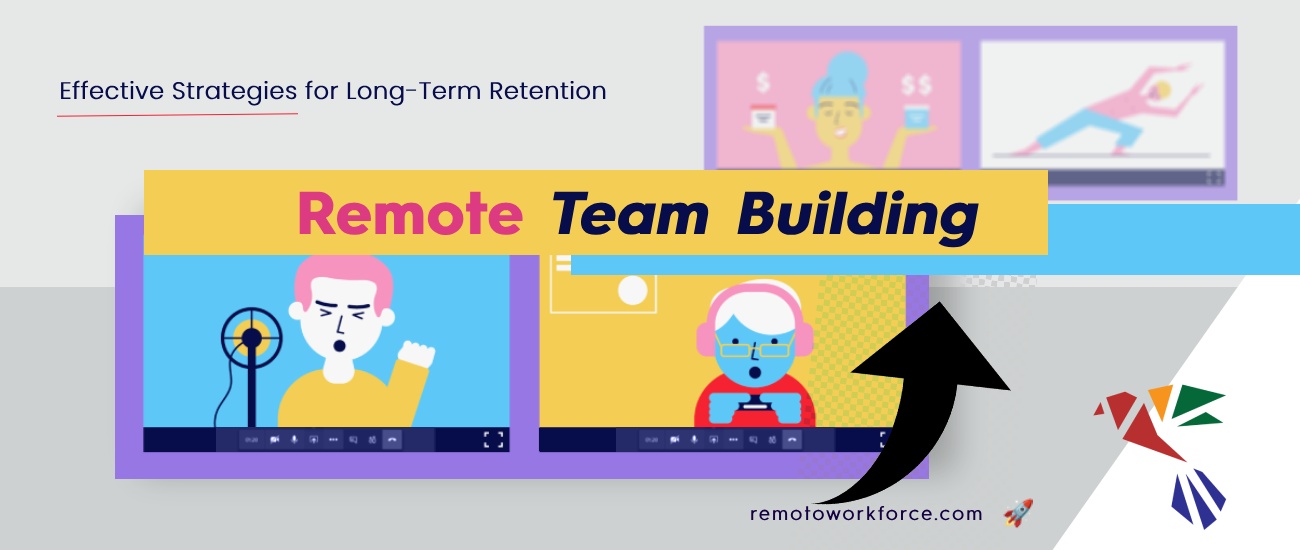The workplace has changed a lot in the past few years. Many businesses now let their employees work from home.
This has some good things, like being able to hire people from anywhere in the world and having more freedom to work how you want. But it also has some challenges. How do you create a cohesive team when your employees are scattered across time zones? And more importantly, how do you retain top talent in this setup?
The answer lies in one powerful concept: remote team building. It’s related to maintaining productivity and fostering trust, engagement, and long-term loyalty. In this blog, we’ll look at the best ways to build a remote team and learn how you can make your team stay and succeed.
Building Trust: The Foundation of Every Great Remote Team
Trust is the glue that holds remote teams together. Collaboration is hard without trust. Employees can feel left out or unappreciated. So, how do you cultivate trust in a remote environment?
Start by focusing on outcomes rather than micromanaging processes. Allow your team members the autonomy to manage their tasks independently while you emphasize what needs to be achieved. This approach not only boosts morale but also encourages creativity and innovation.
Another way to build trust is through transparent communication. Share company updates, decisions, and even challenges with your team.
This openness fosters a sense of belonging and shows that you value their role in the company. Additionally, regular one-on-one check-ins are a great way to build rapport and understand individual team members’ needs and challenges.
Finally, trust is a two-way street. You need to trust your employees, but they also need to trust you. Lead by example—show dedication, accountability, and respect. When your team sees these traits in you, they’ll mirror them in their own work.
Clear Expectations: The Compass for Success
When everyone’s working from different locations, clarity becomes non-negotiable. Setting clear expectations is like providing a compass to your team—it ensures they know where they’re heading.
Begin by defining roles and responsibilities in detail. What does success look like in each role? What are the key deliverables and timelines? By answering these questions upfront, you eliminate confusion and empower your team to focus on their goals.
Equally important is aligning personal goals with organizational goals. Help your employees understand how their work contributes to the larger mission. This connection not only drives motivation but also fosters a sense of purpose.
Consider expectations around communication. For example, norms should be established around response times, meeting attendance, and availability. Clear boundaries make it easier for your team to collaborate effectively without feeling overwhelmed.
Communication That Brings Remote Teams Together
Effective communication is the lifeline of remote teams. Without it, even the most talented team can struggle. But communication in a remote setup needs more than just tools—it needs intentionality.
Start by choosing the right platforms for different purposes. Use tools like Slack for instant messaging, Zoom for virtual meetings, and project management software like Asana for task tracking.
But remember, tools are only as effective as the culture around them. Encourage your team to over-communicate when in doubt and to use asynchronous methods for non-urgent updates.
Regular meetings are another cornerstone of good communication. Daily stand-ups, weekly check-ins, or even casual virtual coffee chats keep the team connected and informed. These interactions create opportunities to address issues, share updates, and celebrate wins.
Finally, create open channels for feedback. Encourage your team to share their thoughts on processes, tools, and even leadership styles. This openness builds trust and ensures that your communication strategy evolves with your team’s needs.
Investing in Growth: The Secret to Retention
One of the most effective ways to retain your top talent is by showing that you’re invested in their growth. Remote workers, like any other employees, want to feel valued and supported in their career journeys.
Offer opportunities for continuous learning. Whether it’s through online courses, certifications, or workshops, professional development not only improves performance but also strengthens loyalty. Make it a point to discuss career goals during one-on-one meetings and provide guidance on how to achieve them.
Mentorship programs can also play a big role. Pair experienced team members with newer ones to create opportunities for knowledge sharing and skill development. This not only enhances team dynamics but also fosters a culture of collaboration.
Lastly, celebrate growth milestones. Whether an employee completes a course, gets a promotion, or achieves a major project goal, recognize their efforts publicly. These moments of acknowledgment go a long way in boosting morale and retention.
Fostering a Strong Remote Culture
Company culture doesn’t stop at the office door—it needs to thrive in your virtual workspace, too. A strong culture is what makes remote teams feel connected despite the distance.
Organize regular virtual team-building activities, such as online games, quizzes, or virtual happy hours. These moments of fun and connection help mimic the camaraderie of a physical office. You can also celebrate team milestones or birthdays to add a personal touch.
Encourage inclusivity by creating spaces for casual interactions. For instance, set up Slack channels for non-work topics like hobbies, pets, or travel. These informal conversations can strengthen relationships and make remote work more enjoyable.
Remember, culture isn’t just about activities—it’s about how people feel. Make sure your team feels heard, valued, and respected. Actively seek input on how to improve the remote work experience and make changes based on their feedback.
Team-Building Activities That Go Beyond Fun
Team-building is more than just fun—it’s about creating meaningful connections and collaboration. In a remote setup, these activities need to be intentional and creative.
Start with virtual games or challenges that promote problem-solving and teamwork. Activities like virtual escape rooms or trivia quizzes are not only engaging but also help improve communication and collaboration.
You can also organize mini-projects that involve cross-functional teams. Working together on non-routine tasks helps employees build trust and learn from each other’s strengths.
And don’t forget about in-person opportunities! If possible, organize occasional meetups or retreats. Face-to-face interactions can solidify bonds that are built online, making your remote team even stronger.
Prioritizing Mental Health and Well-Being
Remote work offers flexibility, but it also blurs the lines between work and personal life. As a leader, prioritizing your team’s mental health isn’t just a nice-to-have—it’s essential.
Encourage work-life balance by respecting boundaries. Avoid scheduling meetings outside of agreed hours and discourage after-hours emails. Lead by example by taking breaks and setting limits on your own availability.
Provide resources for mental health support, such as access to counseling or mindfulness apps. Regularly check in with your team to gauge how they’re feeling and offer support when needed.
Finally, create a culture where it’s okay to talk about mental health. Normalizing these conversations shows your team that their well-being matters, creating a more supportive and resilient workforce.
Feedback: The Key to Continuous Improvement
Feedback is not just about correcting mistakes; it focuses on growth, alignment, and motivation. In a remote setup, feedback is even more critical for maintaining engagement.
Create regular opportunities for your team to share their feedback, whether through surveys, one-on-one meetings, or team discussions. Make sure they feel comfortable being honest and that their input is valued.
Equally important is giving constructive feedback. Be clear, specific, and focus on outcomes rather than personal traits. Highlight strengths before discussing areas for improvement to keep the conversation positive and productive.
Lastly, act on feedback. When your team sees that their suggestions lead to changes, it reinforces trust and encourages further input.
Building Teams That Last
Remote team building is about improving productivity and fostering an environment where team members can thrive, grow, and remain engaged long-term. By focusing on trust, communication, culture, and growth, you can build a team that’s not only high-performing but also deeply committed to your organization.
The future of work is remote, and the companies that excel will be the ones that prioritize their people. Start implementing these strategies today, and watch your remote team transform into a powerhouse of talent, collaboration, and retention.














